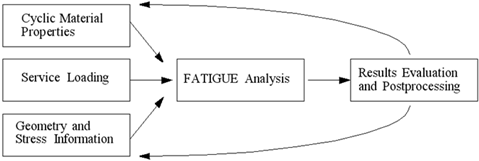XXXXXXXXXXXXXXXXXXXXXXXXXXXXXXXXXXXXXXXXXXXXXXXXXXXXXXXXXXXXXXXXXXXXXXXXXXXXXXXXXXXXXXXXXXXXXXXXXXXXXXXXXXXXXXXXXXXXXXXXXXXXXXXXXXXXXXXXXXXXXXXXXXXXXXXX''"> Introduction
A MSC Fatigue analysis is initiated in one of three ways. The most useful and practical way is either through its own graphical interface or directly through the MSC Patran environment. The stand alone operation is described in
Stand Alone Usage and the MSC Patran environment is described in
The MSC Patran Environment.
A MSC Fatigue job can also be setup outside of any type of graphical environment directly through the MSC Fatigue modules themselves, although this is limiting. See
Other Modes of Job Setup.
Regardless of how a fatigue analysis is set up there are always three basic inputs that must be specified before an analysis can proceed. Only setup for the basic analysis types (
Total Life and Crack Initiation (Ch. 5) and
Crack Growth (Ch. 7)) are explained in this chapter. For other more advanced fatigue analysis setup (
Vibration Fatigue (Ch. 8),
Weld Analysis (Ch. 9),
Software Strain Gauges (Ch. 11),
Multiaxial Fatigue (Ch. 6)), see the appropriate chapter.
Preparing for a MSC Fatigue Analysis
The three basic pieces of information needed to compute a fatigue life estimation using MSC Fatigue are:
• Materials Information: This is information describing the cyclic fatigue properties of the component or material. This can be accomplished using MSC Fatigue’s materials database manager, PFMAT. The materials data may already be found in the materials database, or it may be generated from the UTS of the material based on empirical formulations, or it may be obtained from materials tests or other references and input manually into the materials database. See
Material Management (Ch. 3).
• Loading Information: Loads can be in the form of time histories, power spectral density functions (PSDFs) or cycle definitions (rainflow matrices). The loading is defined externally to the FE model in the case of static and frequency response FE analysis or else must be an integral part of the FE analysis for transient and random vibration analyses. External loading is defined using MSC Fatigue’s time history database manager, PTIME. See
Loading Management (Ch. 4).
• Geometry Information: For most fatigue analyses, this entails the finite element model and the stress or strain results. In the case of a crack growth analysis, a comprehensive library of compliance functions is provided in the module, PKSOL, to define the crack geometry. To obtain the stress/strain information, an appropriate finite element (FE) analysis must have been performed. Any fatigue analysis begins where a finite element analysis ends. Therefore, this guide does not go into any detail concerning model creation or finite element analysis itself.
The fatigue analysis can be thought of as a “five box trick” (as shown in
Figure 2‑1) where the first three are the inputs as described above, the fourth is the actual fatigue analysis, and the fifth is the interpretation and/or postprocessing of the results which could lead to a loop back to the first three inputs for sensitivity studies.
This is an important concept in MSC Fatigue in that it allows you to build a “fatigue model.” Fatigue analysis is a logarithmic process, thus amplifying any errors or discrepancies of the three inputs through the analysis process. Sensitivity studies allow for easy and quick interpretation of resulting life predictions to see how sensitive your model is to variations in any of the inputs.
Figure 2‑1 The MSC Fatigue “five-box trick”

